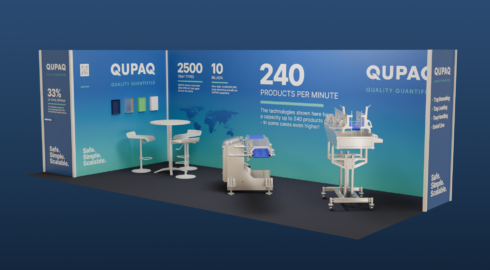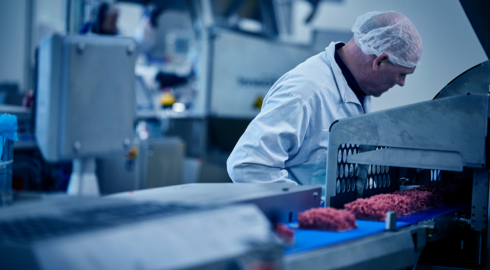
Unleashing Cost Savings: The Power of Automation in Food Manufacturing
Continuing to rely on manual labor is a dead-end to keep up with the projected market demand.
COST-CONTROL:
Human Labor Can Only Produce So Much
In the competitive landscape of the food manufacturing industry, finding ways to optimize production processes is critical to reduce costs and maintain a competitive edge.
One shouldn’t just automate for the sake of automating. Every project needs a set of goals to be achieved before the project can be recognized as a successful implementation.
One area that holds immense potential for cost savings is the packaging and End-of-Line operations.
By implementing automated solutions, food manufacturers can streamline their operations, lower labor costs, minimize product wastage, and improve overall productivity. However, to embark on a successful tray denesting automation project, manufacturers need to carefully consider and be aware of all the factors that play in when defining proper goals – and succeed with them.
Reducing Labor Costs
Since 2014 there have been a rapid climb in labor in the US, only halted during the Covid-19 outbreak. After that the climb have resumed.

Number of employees (thousands) within Food Manufacturing, year over year. From 2014-2023 jobs within Food Manufacturing have grown 17.3%. Qualified labor is in high demand. Data from US Bureau of Labor Statistics.
This will continue to put some constraints on the growth within Food Manufacturing, as qualified workers are in high demand. It also pushes the wages upwards. Labor costs can account for as much as 80% of all production expenses, depending on the specific industry segment, sector, and location of the manufacturer.
Also read: Cost per Unit – Food Manufacturings main KPI during high inflation
Manual tray denesting is a labor-intensive and time-consuming task. By embracing automation, manufacturers can eliminate the need for manual labor, resulting in significant cost savings.
Automating tray denesting allows manufacturers to reallocate their skilled workforce to more value-added tasks, reducing labor costs and improving operational efficiency.
Boosting Productivity
Although the labor force is increasing, it’s not enough to keep up with the increasing consumer demand. Human labor can only produce so much. With an expected market revenue growth of 6,3% (CAGR 2023-2028) and a volume growth of 4,3% expected in 2024, continuing to rely on manual labor is a dead-end to keep up with the projected market demand.

The expected demand for food will grow in the coming years. The graph shows the expected increase in volume in US for various segments. The total volume will grow appr. 20% in the coming years. This require adjustments throughout the entire value chain, especially boosting productivity in a sustainable way. Data from Statista – May 2023.
It is clear that the growth in labor from 2020-2023 have not proportionally added the same output volume, albeit it has grown. Automation is key to release the potential and join the growing market.
Automated tray denesting systems offer impressive speed and efficiency, leading to a substantial increase in productivity. By eliminating manual denesting, the production process becomes faster, ensuring a smooth flow of trays and maximizing throughput. This boost in productivity translates into higher output and the potential for revenue growth.
Also read: What’s the beef with beef?
But it doesn’t stop there. Automating the entire End-of-Line will significantly decrease the Cost per Product rapidly and reach a positive ROI in a very short time.
Minimizing Product Waste
In 2018 a study showed that each year, 1.6 billion tons of food worth about $1.2 trillion are lost or go to waste. That is one third of all food produced globally. The majority of this food waste occurs before products are even finalized and shipped to retailers and consumers.

Food waste occur in all phases of production from farmer to consumer. The study also projects the volume of food loss and waste will rise 1.9% annually from 2015 to 2030 while the dollar value will rise 1.8%. Source: BCG.com.
The issue is becoming critical to protect the resources available and it will most certainly become a global political issue to be addressed in the years to come.
There are several reasons why food becomes waste during the manufacturing, but it very often involves human interaction as the cause.
Also read: Let’s keep it clean in here
Manual denesting processes often result in product damage and wastage, particularly for delicate food items. However, automation minimizes product wastage caused by human errors and inconsistent handling.
By implementing automated tray denesting, manufacturers can ensure consistent and gentle handling of trays, resulting in minimal product damage and waste. This reduction in product wastage not only leads to financial savings but also enhances the overall quality and customer satisfaction.
Factors to Consider in Tray Denesting Automation Projects
When considering a tray denesting automation project, several factors should be taken into account. Careful equipment selection is crucial to ensure reliable, efficient, and compatible solutions. Collaborating with a trusted automation provider, such as QUPAQ, allows for customized solutions tailored to specific production line requirements.
- Equipment Selection:
Choosing the right automated tray denesting equipment is vital for the success of the automation project. Manufacturers should evaluate factors such as speed, reliability, flexibility, and compatibility with their existing production lines. It is crucial to partner with a reputable and trusted tray denesting automation provider, such as QUPAQ, renowned for its reliable and efficient equipment. - Customization and Adaptability:
Food manufacturing facilities often have unique requirements and specific tray specifications. To achieve optimal results, it is essential to collaborate with a tray denesting automation provider that offers customizable solutions tailored to the specific needs of the production line. Customization ensures seamless integration and optimized performance, leading to maximum cost savings and efficiency. - Maintenance and Support:
Regular maintenance and responsive technical support are vital for maintaining optimal performance and minimizing downtime. Manufacturers should choose a tray denesting automation provider that offers comprehensive after-sales service, including preventive maintenance programs and reliable customer support. A robust support system ensures uninterrupted operation and maximizes cost savings in the long run. - Scalability and Future Expansion:
Considering the scalability and potential for future expansion of the automated tray denesting system is crucial. As business needs evolve, the automation solution should have the ability to accommodate increased production volumes and adapt to new tray sizes and formats. Investing in a scalable solution ensures long-term cost savings and future-proofing of the production line.
Automation of tray denesting in food manufacturing presents a significant opportunity for cost savings. By embracing automation, manufacturers can reduce labor costs, increase productivity, minimize product wastage, and enhance operational efficiency. Careful consideration of equipment selection, customization, maintenance and support, and scalability is crucial for the success of a tray denesting automation project. By harnessing the power of automation, food manufacturers can unlock cost-saving potentials and position themselves for long-term success in a competitive industry.
Sources:
https://www.bcg.com/publications/2018/tackling-1.6-billion-ton-food-loss-and-waste-crisis
https://www.bls.gov/iag/tgs/iag311.htm
https://psu.pb.unizin.org/hmd329/chapter/ch13/
https://www.illinoisbank.com/business-insights/automation-food-processing-production-labor-shortages-inflation
https://www.statista.com/outlook/cmo/food/worldwide





